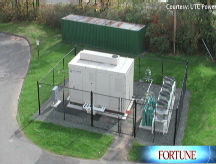Finding the right green fund
Investor daily: There are lots of choices, but many are new and untested. We discovered three with seasoning and size.
(Fortune Magazine) -- Mutual funds are supposed to simplify investing, but it doesn't always work out that way. Let's say you're looking for a fund that invests in green technologies. There are dozens of choices, including exchange-traded funds (ETFs), which track narrow indexes in everything from wind power to potable water. The catch? Most are as new and unproven as the companies they invest in. So we set out to find funds with experienced managers and established records. First, we asked research firm Lipper to produce a list of green funds. Then we excluded those with less than five years' performance or less than $100 million in assets. That left us with just three contenders - a slim field, to be sure - but these veterans offer a range of options for different risk appetites.
First up: Portfolio 21 (PORTX). With a broad mandate to invest in companies that address resource scarcity and other environmental challenges, the managers of this $154 million global large cap have built a diverse portfolio that spans sectors and cushions against drops. "We prefer to have less volatility than you'd get from investing in smaller caps or focusing on special technologies," says chief investment officer Leslie Christian. That's why top holdings include both direct energy plays like Danish wind-equipment maker Vestas and pharma giant Novartis, which wins points from the fund's managers for its energy-efficiency policies. By sticking to established names, the fund produced an 8.1% five-year annual total return through Sept. 30. And though it's down 35% this year, Portfolio 21 is still beating nearly 90% of its global stock fund peers, according to Morningstar.
For more focused green investing, there's the New Alternatives Fund (NALFX). Launched by the father-son team of Maurice and David Schoenwald in 1982, this $246 million fund has posted an 8.6% annualized total return from inception through the end of September, with a heftier 11% five-year return. The Schoenwalds invest in midsized companies, favoring utilities and industrials like Spanish wind-turbine manufacturer Gamesa. They apply a strict social screen to their holdings. For instance, New Alternatives doesn't own shares of Chinese companies because of concerns about low-wage labor.
For a real adrenaline rush, look no further than Winslow Green Growth (WGGFX). Led by Jackson Robinson, who founded Winslow Management as a green investing house in 1983, this aggressive small-cap growth fund has dropped an excruciating 56% this year. Here's why. In downturns, its green-tech portfolio gets hit in three ways: for investing in small startups, for betting on hyper-growth stocks, and for owning so few of them. About 46% of the fund's assets are in just ten stocks. In 2008 big holdings like geothermal products maker LSB Industries have plunged more than 50%. "There's tremendous disconnect between the fundamental valuations of the companies and the price of the stocks," says Robinson, who has bulked up on some of his positions.
When its picks pay off, this $280 million fund rides high. It has boasted double-digit gains since 2003, when it had a remarkable 92% return. "This is an exceptionally aggressive fund, and it's capable of amazing upside," says Morningstar analyst Bill Rocco. Still, wild swings are inherent in this kind of fund, so he recommends it only as a tiny, spicy dollop on an otherwise well-balanced portfolio.
Has the stock market turmoil got you wondering about how to invest now? Let us know your investing question. We'll answer it in our next Investor Daily. E-mail Fortune. ![]()
-
 The retail giant tops the Fortune 500 for the second year in a row. Who else made the list? More
The retail giant tops the Fortune 500 for the second year in a row. Who else made the list? More -
 This group of companies is all about social networking to connect with their customers. More
This group of companies is all about social networking to connect with their customers. More -
 The fight over the cholesterol medication is keeping a generic version from hitting the market. More
The fight over the cholesterol medication is keeping a generic version from hitting the market. More -
 Bin Laden may be dead, but the terrorist group he led doesn't need his money. More
Bin Laden may be dead, but the terrorist group he led doesn't need his money. More -
 U.S. real estate might be a mess, but in other parts of the world, home prices are jumping. More
U.S. real estate might be a mess, but in other parts of the world, home prices are jumping. More -
 Libya's output is a fraction of global production, but it's crucial to the nation's economy. More
Libya's output is a fraction of global production, but it's crucial to the nation's economy. More -
 Once rates start to rise, things could get ugly fast for our neighbors to the north. More
Once rates start to rise, things could get ugly fast for our neighbors to the north. More








